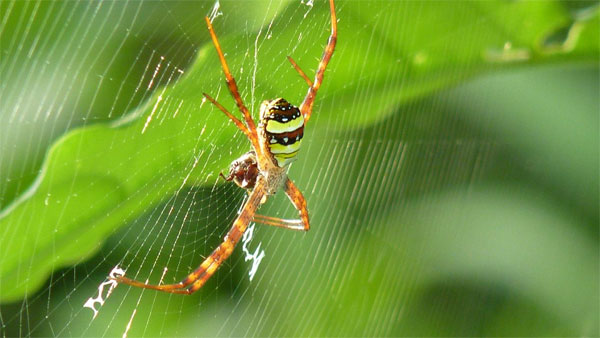Spider silk can transmit sound waves very well
Scientists have found that sophisticated spider webs can produce sounds like a stringed instrument.
Spider silk has long been intriguing for scientists because of its strength and toughness. But recently, people have begun to pay attention to the sound conductivity of spider silk.
Due to poor eyesight, spiders cannot see prey stuck in the network. They must rely on vibrations from silk threads to locate prey and detect damage on the spider web. When the spider plucked and pulled the veil, sending spreads across directions on the spider web, it could sense vibrations on all eight of its legs.
The study of the sound properties of this spider silk was carried out by Beth Mortimer, a graduate student of Oxford Silk Group, University of Oxford. She said spiders create vibrations on the web to collect information. Because there are eight legs, they can cover many different directions. Her most recent research on how spider silk can convey very detailed information has been published in Advanced Materials.

In the experiments, Mortimer and researchers used single filaments obtained from two different lattice spiders: Nephila edulis and Araneus diadematus. They found that the silk of these two spiders can vibrate with a frequency range that varies more widely than other natural and synthetic fibers.
Mortimer said: 'Each violin string can only be tuned according to certain notes. But the violin with strings made of spider silk can be wired in a very wide range of sounds. "
To measure how spider silk vibrates, Mortimer and his colleagues use a strange way : they launch a warhead into a piece of silk and use a super speed camera to return to the vibrations from this collision. In addition, they use lasers to measure even the smallest vibrations.
Spiders are much more handful of silk vibrations. They create transverse waves by bobbing up and down on the web and creating longitudinal waves by stripping silk threads.
These waves change the vibration frequency of the silk by twisting the protein structure of the silk and adjusting the tension of the silk yarn on the network. These techniques help spiders identify any damage on the web and the prey has trapped.
Because spider silk can vibrate with so many different frequencies, the spider can sense small vibrations of just 100 nanometers - about one-thousandth the thickness of a human hair.
Now that Mortimer and his colleagues have identified some of the vibrational properties of single spider silk fibers, they began to study how these properties could change during the web weaving process. In addition to helping scientists better understand the biology of spiders, this information could also help materials scientists design super-sensory devices using spider silk, such as machines. Hearing Aid.
- Discover the mystery of spider silk
- Producing artificial spider silk lighter than cotton, more durable than steel
- Spider-Man's weapons are not logical about science
- Video: How to clean up the silk inside a spider?
- Found a way to transform genes to create spider silk like Spider Man
- See the silk spider, you will have to recognize this is a great architect of the animal world
- Detection of spider silk formation mechanism
- Lightweight fabric from artificial spider silk
- The world's rarest silk weaves from the silk of millions of spiders
- New research: using spider silk will help treat fractures effectively
- Bulletproof vests will be made of spider silk
- The mystery of the strength of spider silk has been discovered
 Why do potatoes have eyes?
Why do potatoes have eyes? 'Tragedy' the world's largest carnivorous life: Death becomes ... public toilet
'Tragedy' the world's largest carnivorous life: Death becomes ... public toilet Tomatoes were once considered 'poisonous' for 200 years
Tomatoes were once considered 'poisonous' for 200 years Detecting microscopic parasites on human face
Detecting microscopic parasites on human face